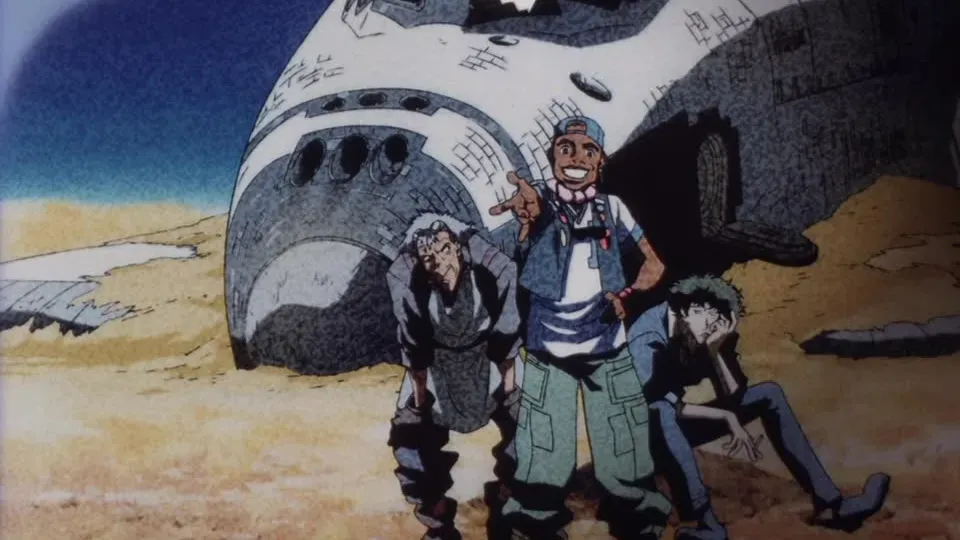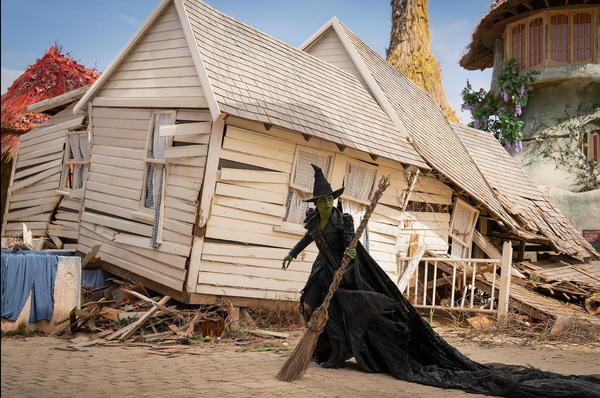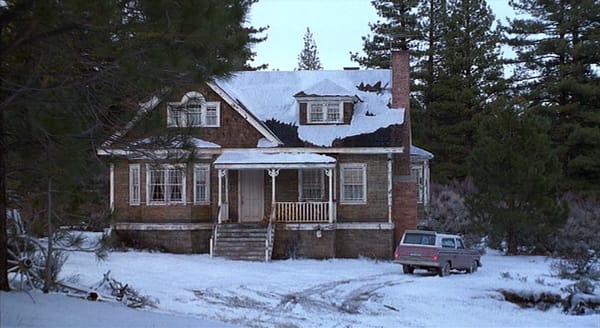Cowboy Bebop: "Wild Horses" and "Pierrot le Fou"
In which we get to see how much the crew has gelled and how big Spike's death wish has gotten

(This is the 10th installment of my biweekly recaps of Cowboy Bebop, the TV Tokyo animated series that ran from 1998 to 1999 to cult fascination and critical acclaim. I’ve never seen it! These recaps are only available to paid subscribers.)
- “Wild Horses” (originally aired March 6, 1999 [Wowow], and November 5, 2001 [Adult Swim])
- “Pierrot le Fou” (originally aired March 13, 1999 [Wowow] and November 5, 2001 [Adult Swim])

When I first started thinking about this recap, I realized I didn't have much to say about either of these episodes. "Wild Horses" is an incredibly entertaining caper. "Pierrot le Fou" is the closest I've seen any show that doesn't feature Bruce Wayne come to the vibe of Batman: The Animated Series. Those are my opinions. I can do something else now, right?
There's more going on here, though. While, yes, I'm not going to wax as rhapsodic about these episodes as I have some of our recent Faye Valentine spotlight episodes, I'm impressed by how subtly they contribute to the series' overall serialized storyline. "But Emily!" you say in my imagination. "These episodes aren't serialized at all!" And to that, I say: That's what you think!
In the modern TV landscape, we've come to have a very anemic understanding of what serialization can be. Serialization is the ongoing progression of plot, and the plot is directly tied to character arcs. To understand the characters, we have to understand the plot, and to understand the themes, we have to understand the characters. And so on.
What's striking is how little this conforms to how most great TV dramas have created serialized stories. Take The Sopranos. Yes, that show had long-term character arcs, but any given season would feature any number of side quests, tangents, and off-road adventures. Tony Soprano's many machinations often took a back seat to, most famously, two of his underlings getting lost in the woods. Yes, The Sopranos often had deeper layers of serialized storytelling in every episode. Still, it also usually found a way to tell a one-off story of the week.
I sometimes feel like a broken record when I talk about this, but that approach was the usual one for most of TV history. If you wanted to tell a larger story, you had to make sure it broke down into smaller ones. What's even worse is that the increasingly convoluted serialization of TV is filtering into everything else. The early films in the Marvel Cinematic Universe, for instance, mostly stood alone. Now, however, the interdependence of the MCU's many projects means that most of its movies no longer really have first acts. They are, instead, in constant motion. That can be fun, but it can also be tiring.
What does any of this have to do with these two episodes of Cowboy Bebop? Quite a bit, actually. When you think about where "Wild Horses" and "Pierrot le Fou" fall in the season, they seem like palate cleansers after a long string of heavy episodes delving into the characters' psychological states of mind and tragic backstories. If I were watching straight through (instead of watching two episodes every few weeks), the jump from "Speak Like a Child" to "Wild Horses" might feel jarring, as the series went from one of its most melancholy episodes to one of its most purely entertaining.
Or would it? For starters, "Speak Like a Child" has a lot of wacky caper energy until its ending. However, what's even more relevant is that "Wild Horses" might have the glossy sheen of a fun caper, but at its heart, it's a story about how these broken people all accidentally make each other better. Similarly, "Pierrot le Fou" seems like an oddity, a one-off horror story that feels like a great lost issue of a comic book. Peel back its outermost layer, however, and you find a story about just how much Spike Spiegel's death wish has come to keep him from seeing anything but his own self-regard.

Yet Spike's death wish also comes up in "Wild Horses" (when he seems perfectly fine with his almost certain death). What's more, the crew's ability to work together to take care of each other also comes up in "Pierrot," when Jet and Ed dig up information on Pierrot's origins and Faye heads down to the amusement park to save Spike.
Thus, after many episodes in which the characters' pasts were explained to us through flashbacks and expositional monologues and meetings with old friends, these two episodes deal with the characters' presents but offer plenty of rich character work in the process. I'm not someone who believes that character can only be expressed through action. Great expositional dialogue exists, and sometimes you need to grit your teeth and do a flashback. However, if you're sticking to your present timeline, expressing character through action is usually the best method. And that's what these two episodes do.
I think "Pierrot" is particularly instructive in this regard. At first glance, it's just a dark, scary, oddly funny half-hour about a mad serial killer clown. The other episodes that it feels most like are Spike's assorted flashback episodes, which may subtly nod toward "Pierrot's" placement as a Spike-centric installment. Look at the episode even more through that lens, and we get an even better idea of why Spike might be so driven to take down Pierrot. If he sees a slightly macabre reflection of his past in Pierrot — both in terms of the villains he has faced and the pain he has endured — then his inability to leave (again) a mad clown serial killer alone takes on a dimension beyond "Spike feels the need to stop a murderer." The best heroic storytelling usually explores why characters are so driven to stop evil beyond "they are good guys." "Pierrot le Fou" offers a take on Spike that paints him both as someone trying to make the universe slightly better and as someone who doesn't terribly care if he lives or dies. He's both, and that's what makes him such a good hero.
"Wild Horses" is slightly less character-dense, but it still offers a chance to watch everybody on the team working together as a relatively efficient unit. Even as the pirates that the crew tries to bring down keep finding new ways to foil them, Jet, Faye, and Ed adapt to keep pursuing their ultimate goal of capture. And once Spike gets involved, the whole plan kicks up a notch, especially when Spike's pals Miles and Doohan fly up into orbit in an old space shuttle (!!) to scoop the Swordfish II up into their cargo hold. Surviving in space requires cooperation, even in a lonely job like bounty hunting. The Bebop gang has gotten this far because they know how to work together. They may not always like each other, but they function perfectly as a team.
Throughout the run of Cowboy Bebop, I have been struck by how masterfully it blends tones. When you watch one episode, you don't know what to expect from the next, outside of the show's one two-parter so far. Both "Wild Horses" and "Pierrot le Fou" continue the feeling of being part of a mixtape created with wild abandon. The episodes of Bebop are more properly called "sessions," and in thinking about how these two episodes fit into the show, I realized that the season's structure really does resemble a mixtape more than anything else. By smashing two unexpected tones against each other, the show sees how they create a new harmony through their juxtaposition.
Like the best mixtapes, however, this TV season has a throughline about the weird little family on board this weird little spaceship. "Wild Horses" and "Pierrot le Fou" feel like they might be throwaway episodes, but they both underscore how much these people fill in the gaps in each other. They're inessential episodes to the broader story arc; they're completely essential to actually understanding the show. And that's the way serialization should be.

Other thoughts I thought:
- The "next week on" for "Pierrot" — which is just the guy laughing diabolically over footage of him killing people — is just another example of why this show's "next week on" montages are the best.
- The end of "Pierrot" is a little cheap, but it's so over-the-top that I don't mind. I also found the reveal of Pierrot's greatest fear (kitties!) to be clever, so I didn't mind when he got crushed by an enormous amusement park mascot. (Okay, also, I didn't mind because how many other shows feature a character killed by a giant amusement park mascot?)
- Bebop's presentation of the ISSP as a bunch of corrupt, no-good pieces of shit is very in keeping with its noir vibes. In any good noir, the cops are not to be trusted and, indeed, might be worse than the criminals themselves. Noir usually involves people working outside the boundaries of law enforcement for that reason.
- Faye and Jet's sibling-esque vibe is becoming one of my favorite relationships in the show. It's clear that Faye and Spike care deeply for each other (if not yet romantically), but her relationship with Jet is similarly full of care and very, very different.
- I mostly followed the plot of "Wild Horses," but it involved some backtracking and consulting the show's wiki. That might be because I watched the episode when I was sleepy, but it does strike me as having one of the show's more convoluted plots. It's a blast, however.
- Jet casually tossing off that there's nothing as pure and cruel as children has big Charles Schulz vibes.
- I love that Faye goes after Spike when he goes to take on Pierrot. I love even more that she's almost immediately knocked unconscious after getting a few good shots in. To some degree, Spike has to face this demon alone.
- I find a little of Ed goes a long way, but I do love it when she gets super hype about doing some weird computer shit.
- What if the final bonus installment of this recap series was me taking a trip to Space Land? Does anybody want to fund the trip?
Next time: I'm taking June 20th off from the newsletter, as I will be on vacation, so I will see you June 27th with the beautifully titled "Boogie Woogie Feng Shui" and "Cowboy Funk."
And after that... We will cover the rest of this show across three installments, publishing June 27th, July 11th, and July 25th. After that, I would love to watch the movie, but I might have to get creative, as it's not streaming in the US. (It does appear to be on Blu-Ray, which is good.) And I also might check out the Netflix series. Might.




